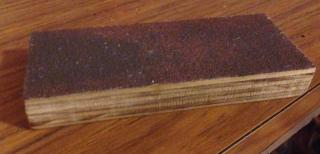20-05-2014, 10:33 PM
Thought I'd put up a couple of pic of how I put together my Racing Rarebears.
These are the naked Rarebears that come with no decals or covering.
The first thing to do is remove all the little nibs that are dotted over the surface of the foam parts. These are formed by holes in the mould to let the air out as the parts are pressed into shape. They cause a fair bit of drag if left on, so because we want a slippery, fast plane, off they come!!

You can see from this photo, just what I'm talking about. The best way to remove them is with a soft block and some 800 grit paper. This takes them off with out scratching the surface or digging or tearing into it. You may also notice a bit of a dag along the trailing edge of the ailerons, like a bit of flash that makes the trailing edge look wider than it is. It's hard to see in a photo but if you run your finger back past the trailing edge you can defiantly feel it. I Remove this one as well.
Another thing with some Rarebears is that the carbon spar strip is proud of the underside of the wing. This isn't much good for going fast and needs to be fixed.

So I carefully sand it down flush with some 120 grit paper glued to a block of plywood
I don't cut into the wing, just sand that little bit of spar till it's flush. If your worried about diging into the wing a strip of masking tape down either side of the spar will protect the foam and make it easy to only attack the carbon that's sticking out. It will also stop the black carbon dust staining the snow white foam.


Here's the block I use for sanding the spar. It's much causer than the one I use to take the little nibs off.
Rarebears need a good colour scheme!!
They are small and fast, so colours that aid in orientation are a must!!
With 4 of the same airframes in one race, it pays to be flying one that stands out and is easy to track. Every thing helps and everything needs too, when your racing.
My colour scheme is red white and blue on top and yellow and blue on the bottom. I use acrylic lacquer for painting my rare bears. This is automotive paint and is available in touch up cans from supacheap auto. It doesn't attack the foam at all and is a fast and extremely durable finish. It's very nice to spray much better than the cheap enamels that you get from bunnings. It doesn't bleed under masking tape and dries very rapidly as well.

These are the naked Rarebears that come with no decals or covering.
The first thing to do is remove all the little nibs that are dotted over the surface of the foam parts. These are formed by holes in the mould to let the air out as the parts are pressed into shape. They cause a fair bit of drag if left on, so because we want a slippery, fast plane, off they come!!
You can see from this photo, just what I'm talking about. The best way to remove them is with a soft block and some 800 grit paper. This takes them off with out scratching the surface or digging or tearing into it. You may also notice a bit of a dag along the trailing edge of the ailerons, like a bit of flash that makes the trailing edge look wider than it is. It's hard to see in a photo but if you run your finger back past the trailing edge you can defiantly feel it. I Remove this one as well.
Another thing with some Rarebears is that the carbon spar strip is proud of the underside of the wing. This isn't much good for going fast and needs to be fixed.
So I carefully sand it down flush with some 120 grit paper glued to a block of plywood
I don't cut into the wing, just sand that little bit of spar till it's flush. If your worried about diging into the wing a strip of masking tape down either side of the spar will protect the foam and make it easy to only attack the carbon that's sticking out. It will also stop the black carbon dust staining the snow white foam.
Here's the block I use for sanding the spar. It's much causer than the one I use to take the little nibs off.
Rarebears need a good colour scheme!!
They are small and fast, so colours that aid in orientation are a must!!
With 4 of the same airframes in one race, it pays to be flying one that stands out and is easy to track. Every thing helps and everything needs too, when your racing.
My colour scheme is red white and blue on top and yellow and blue on the bottom. I use acrylic lacquer for painting my rare bears. This is automotive paint and is available in touch up cans from supacheap auto. It doesn't attack the foam at all and is a fast and extremely durable finish. It's very nice to spray much better than the cheap enamels that you get from bunnings. It doesn't bleed under masking tape and dries very rapidly as well.
“The knack of flying is learning how to throw your machine at the ground and miss.”
"When once you have tasted flight, you will forever walk the earth with your thoughts turned skyward, for there you have been, and there you will always long to return." ~Leonardo Da Vinci





 Smuzz I owe you one !!
Smuzz I owe you one !!

 paaatience !!
paaatience !! paaaaaatience
paaaaaatience  paaaaaaatieeence
paaaaaaatieeence  dooooohhhh !!!
dooooohhhh !!! 

